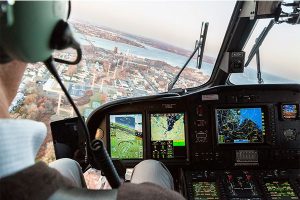Infrared Images Combine with Data to Deliver Enhanced Vision

When a large, commercial aircraft approaches an airport for landing, its pilot knows exactly where his or her craft is in relation to the ground — even in low visibility — through a combination of radio signals and high-intensity lighting, according to a Scientific American article.
Pilots of smaller aircraft — such as private jets and helicopters — do not have such technology and must rely on a different set of skills and tech, according to the article. In serious weather situations, accidents are slightly more common due to “controlled flight into terrain” (CFIT) incidents. According to a NASA report, over 30% of fatal commercial airline accidents globally are categorized as CFIT.
Pilots of all aircraft need to avoid terrain and obstacles during all phases of flight. Key technologies are being developed to enhance operational safety for the unique situations pilots face when operating at low flight levels — where the need for continuous awareness of obstacles and terrain is critical.
Solutions on the horizon
Engineers are constantly working to develop state-of-the-art vision enhancing technologies to aid helicopter pilots. According to a PR Newswire article, those at Dassault are working on a Combined Vision System (CVS) called FalconEye, while Honeywell Aerospace‘s Synthetic Vision Systems (SVS) have been a staple in the industry. The Honeywell SVS includes a 3-D view with computer-generated terrain overlaid with advanced symbology for increased situational awareness.
Dassault’s FalconEye CVS uses thermal and synthetic imaging. According to an Aviation Week article, this combined system approach means that real-time Enhanced Vision System (EVS) images are placed as an overlay on data-derived synthetic images. On the same display, this combined visual allows for a more precise approach and landing.
An eye on the horizon
The information provided by the CVS systems is particularly useful at night and during degraded visual conditions, according to Honeywell. Pilots will also enjoy reduced workload as buildings, oil rigs, ships, and other obstacles are accurately depicted on the visual display, leaving the pilot free to focus on the mission.
According to the Scientific American article, Honeywell is likely to have some competition when its CVS hits the market in the next few years as others, including Ensco Inc., are also developing combined synthetic views.
You can reach our sales specialists today at sales@L-Lint.com, call us any time at +1.305.754.3313, or visit us online.